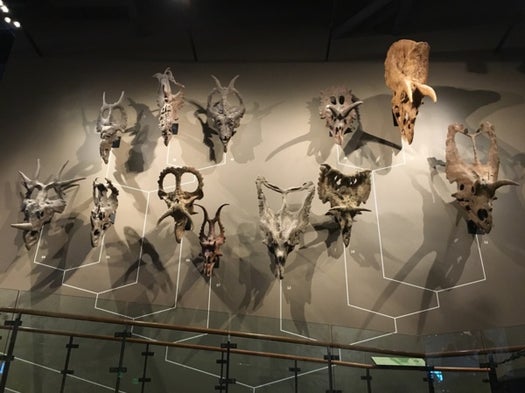
Horned dinosaurs were nothing if not ostentatious. Their skulls were packed with ornaments of varying shapes and sizes, easily-distinguishable splashes of horns and bosses that allows us to tell one species from the next as we study their skulls today. During their peak, about 80-75 million years ago in the environs of western North America, these hulking herbivores seemed to be in some kind of evolutionary contest to see who could originate the most striking headgear.
But why?
Paleontological views on ceratopsian frills and horns have been in flux ever since the dinosaurs were recognized by science. At first it seemed obvious that the likes of Triceratops were fitted with osteological equivalents of lances and shields to fend off predators. More recently, experts have been arguing over a different set of possibilities. What were once interpreted as weapons have been recast as social signals. The question is what kind of currency the horns carried. Were they markers of species - allowing neighboring dinosaurs to recognize their own kind? - or did they carry some other signal, such as social rank or an amorous advertisement to potential mates?
This mystery was a significant part of a lively exchange of opposing papersa few years ago, but resolution didn’t settle out of the back-and-forth. So the investigation continues, with a new paper by paleontologist Andrew Knapp and colleagues looking at one particular facet of the puzzle - species recognition.
Back in 2010 paleontologists Kevin Padian and Jack Horner proposedthat species recognition could explain the evolution of “bizarre structures” like horns, plates, and crests in dinosaurs. “Bizarre structures amount to an advertisement for positive association,” they wrote - a particular constellation of distinct features could allow dinosaurs to easily distinguish their own species from others and confer other information such as age, mating availability, or safety within a group. The problem is that species recognition is poorly-understood as a driver of evolutionary change, so Knapp and colleagues decided to test the species recognition hypothesis by looking at horned dinosaur species that lived shoulder-to-shoulder.
The focus on neighboring dinosaurs - or what experts call sympatric species - is a critical part of the test. That’s because the species recognition hypothesis would predict that horned dinosaurs living in the same place at the same time would diverge most drastically from each other. There would be increased pressure for species that shared space to be dramatically different to help members of those distinct species to maintain ranks and avoid costs like being gored by an angry member of another species. To that end, Knapp and colleagues looked at 350 characteristics across 46 horned dinosaur species to determine if contemporaneous ceratopsians truly were the most different from each other.
The results were stark. “We find no support for the hypothesis that sympatry correlates with higher ornament divergence in ceratopsian dinosaurs,” Knapp and coauthors conclude, noting that horned dinosaurs that overlapped in space and time were only as different from each other as comparative species chosen at random. Sharing the same habitat did not spur contemporary species to become significantly different from each other.
And yet, the paleontologists found, horned dinosaur ornaments evolved into new arrangements much faster than other parts of their bodies. It’s something of a running joke that horned dinosaurs are just different heads on the same chassis. The new study adds actual data to this impression, meaning that either there was a greater evolutionary push to evolve vastly different horn arrangements or that that bodies of these dinosaurs were under what’s called “stabilizing selection,” the biomechanical traits of their bodies being more resistant to change.
The reason for this pattern, however, remains unknown. Knapp and colleagues favor a hypothesis that carries a different sort of social function. Novel horn arrangements might have become favored during courtship and mating, the natural variation of horn shapes continually pushed in new directions by factors like competition for mates or the aesthetic preferences of those mates themselves. This would make the horns and frills of these dinosaurs expressions of dinosaurian fashion, the ceratopsian fossil record tracking what was haute couture in the Cretaceous.
The views expressed are those of the author(s) and are not necessarily those of Scientific American.
https://blogs.scientificamerican.com/laelaps/the-latest-in-horned-dinosaur-fashion/
